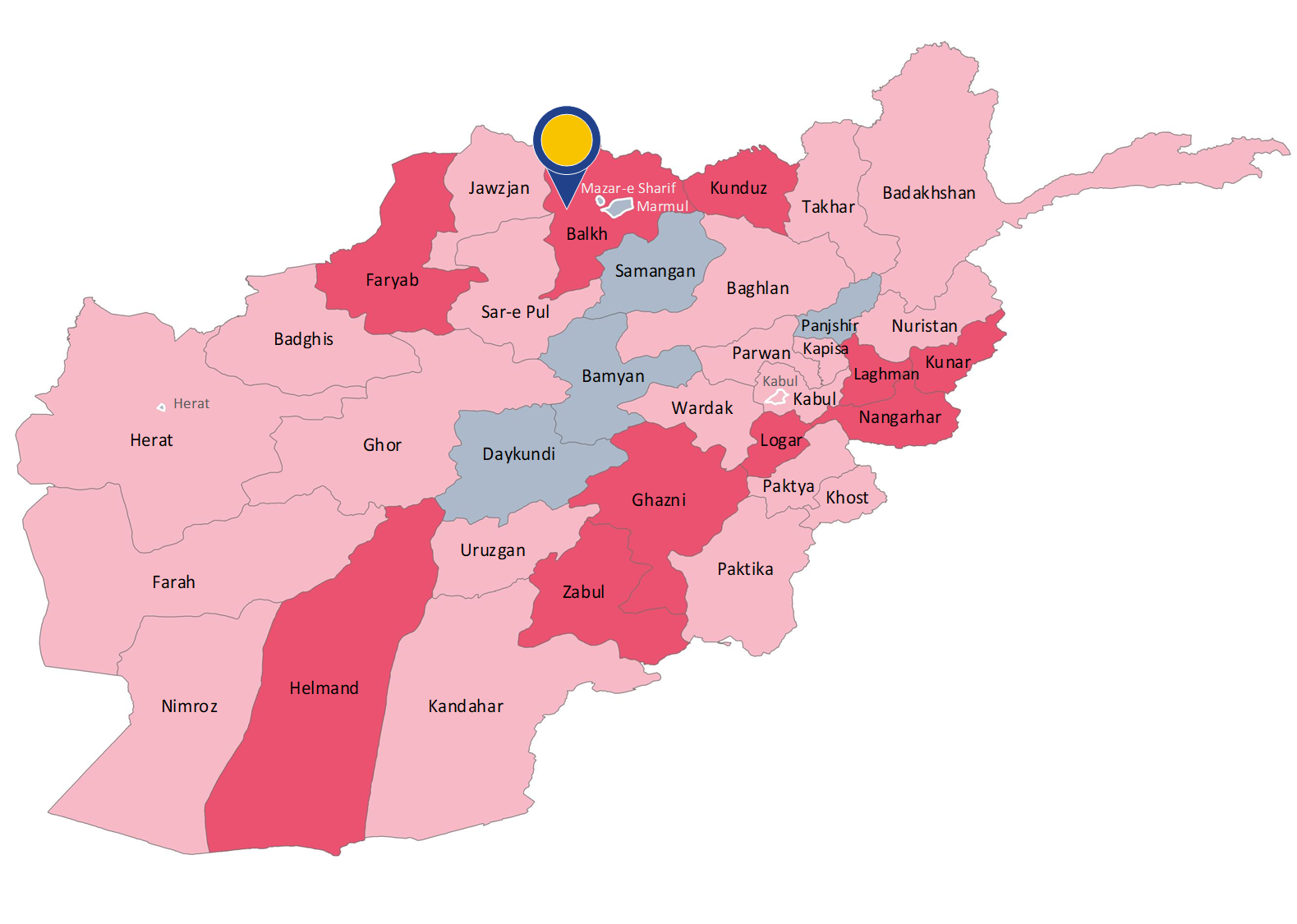|
⚠ |
|
Please note that this country guidance document has been replaced by a more recent one. The latest versions of country guidance documents are available at /country-guidance. |
Balkh province has a population of approximately 1 509 000. It is an ethnically diverse province. It is situated in the northern part of Afghanistan, sharing an international border with Uzbekistan, Turkmenistan and Tajikistan, and bordering Kunduz, Baghlan, Samangan, Sar-e Pul, and Jawzjan. It consists of 15 districts. The provincial capital is Mazar-e Sharif. A highway is leading to the Uzbek border crossing point, branching off the Ring Road east of Mazar-e Sharif. A highway connecting Balkh to Bamyan is under construction.

Up until early 2019, Balkh was usually described as one of the relatively calm and most stable provinces. The resignation of the former governor of Balkh, former warlord Atta Mohammad Noor, was considered a contributing factor to the worsening security situation in Balkh. Subsequently, criminal activities increased in Balkh’s capital. Compared to other northern regions, the Taliban had a much smaller presence in Balkh. Nevertheless, their influence reportedly increased in 2019 and there were reports of Taliban activity in nearly all of Balkh’s districts. It was also indicated that ISKP had increased its influence in all provinces in the northern region, including Balkh. However, no security incidents were specifically attributed to ISKP within the reporting period.
The majority of districts in Balkh were categorised by the LWJ as under government control, with three districts categorised as contested and one district categorised as under Taliban control.
ACLED collected data on 811 violent events in the period from 1 March 2019 to 30 June 2020 (average of 11.7 incidents per week), of which 631 were coded as ‘battles’, 162 as ‘explosions/remote violence’ and 18 as ‘violence against civilians’. Balkh district stood out as the district where most violent incidents were recorded during this period. On the other hand, ACLED did not record any security incidents during this period in the district of Marmul.
The security situation in Balkh province has been deteriorating in 2019 and in the first months of 2020 Balkh was reportedly one of the four most active areas of conflict. Most of the violent incidents in the province were armed clashes, with the majority of attacks by the Taliban on Afghan security forces, including members of PGMs, or attacks on military or police facilities, such as checkpoints, bases, and on convoys and vehicles, as well as attacks on government officials and employees. Heavy fighting and clashes were reported in several districts, leading to casualties. Operations and attacks were carried out by Afghan security forces against AGEs, some of them backed by airstrikes. AGEs used roadside bombs or IEDs to target security forces or government officials. Some of these incidents resulted in casualties among civilians. Violence against civilians also included abductions and killings by the Taliban. UNAMA also noted a consistent pattern in the use of civilian locations by AGEs when carrying out their attacks in Afghanistan, which exposed civilians to risks of attack by pro-government forces.
Further impact on civilians included the setup of Taliban checkpoints along the Mazar-Shiberghan Highway, looting of medical supplies, and blocked access to water and communication networks in Balkh district.
UNAMA documented 277 civilian casualties (108 deaths and 169 injured) in 2019, representing 18 civilian victims per 100 000 inhabitants. This was an increase of 22 % compared to 2018. Leading causes of civilian casualties were ground engagements, followed by non-suicide IEDs and targeted killings. In the first half of 2020, UNAMA ranked Balkh province first in terms of civilians most affected by the conflict, documenting 344 civilian casualties in the province.
RS ranked Balkh in the category of provinces where the number of civilian casualties was between 51 and 75 for the first quarter of 2020; between 51 and 75 civilian casualties were also recorded in the second quarter.
In the period 1 March 2019 – 30 June 2020, 22 253 persons were displaced from the province of Balkh, of whom more than 99 % were displaced within the province itself. In addition, some internal displacement to Balkh was reported from Faryab province, and to a lesser extent from Jawzjan and Sar-e Pul provinces.
|
|
Looking at the indicators, it can be concluded that ‘mere presence’ in the area would not be sufficient to establish a real risk of serious harm under Article 15(c) QD in the province of Balkh, however, indiscriminate violence in most parts of the province reaches a high level, and, accordingly, a lower level of individual elements is required to show substantial grounds for believing that a civilian, returned to the territory, would face a real risk of serious harm within the meaning of Article 15(c) QD.
|
||
|
|
In the provincial capital of Mazar-e Sharif and in the district of Marmul, indiscriminate violence is taking place at such a low level that in general there is no real risk for a civilian to be personally affected by reason of indiscriminate violence within the meaning of Article 15(c) QD. However, individual elements always need to be taken into account as they as they could put the applicant in risk-enhancing situations.
|
